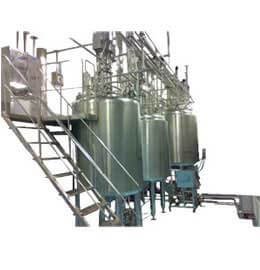Pharmaceutical machines, also known as pharmaceutical equipment, refer to the various types of machinery used in the production, processing, packaging, and labeling of pharmaceutical products. These machines play a crucial role in ensuring the quality, safety, and efficiency of pharmaceutical manufacturing processes. Here are some common types of pharmaceutical machines:
- Tablet Press Machine: This machine is used to compress pharmaceutical powders into solid tablets. It applies pressure to form tablets of consistent size, shape, and weight.
- Capsule Filling Machine: This equipment is employed to fill empty gelatin capsules with pharmaceutical powders or granules. It ensures accurate dosing and sealing of capsules.
- Blister Packaging Machine: Blister packaging machines are used to create individual blister packs, which consist of a cavity or pocket made from a formable web, usually aluminum foil or plastic. The pharmaceutical product is placed in the cavity, and the pack is sealed.
- Liquid Filling Machine: These machines are used to fill liquid pharmaceutical products, such as syrups, suspensions, and solutions, into bottles or containers. They ensure accurate filling levels and prevent spillage.
- Aseptic Processing Equipment: This includes machines and systems designed to handle sterile pharmaceutical products to prevent contamination. This can include sterile filling machines, autoclaves, and isolators.
- Sterilization Equipment: This category encompasses machines used to sterilize equipment, containers, and packaging materials to ensure the sterility of pharmaceutical products. Common methods include autoclaving, gamma irradiation, and chemical sterilization.
- Packaging Line Equipment: This includes various machines used in the final stages of pharmaceutical production, including labeling machines, capping machines, and cartoning machines.
- Mixers and Blenders: These machines are used to mix different components of pharmaceutical formulations, ensuring uniform distribution of active ingredients.
- Granulation Equipment: Granulators are used to convert fine powders into granules, which are easier to handle and process in subsequent steps of pharmaceutical manufacturing.
- Drying Equipment: Drying machines are used to remove moisture from pharmaceutical products after processes like granulation or coating.
- Milling Equipment: Milling machines are used to reduce particle size in pharmaceutical powders, which can be important for drug dissolution and absorption.
- Tablet Coating Machine: This equipment is used to apply a coating to tablets, which can serve various purposes, including taste masking, controlled release, and protection from moisture.
These are just some examples of the many types of pharmaceutical machines used in the industry. Each type of machine plays a critical role in the production of safe and effective pharmaceutical products.
What is a medicine filling machine and how does it work?
A pharmaceutical filling machine is a piece of equipment designed to accurately dispense and package medications into various types of containers, such as bottles, vials, or blister packs. These machines are a crucial part of pharmaceutical manufacturing, ensuring precise dosing and maintaining product integrity. Here’s an overview of how a typical pharmaceutical filling machine works:
- Container Preparation: Before the filling process begins, containers are typically cleaned, sanitized, and positioned on the machine’s conveyor system.
- Product Supply: The pharmaceutical product, which can be in liquid, powder, granule, or tablet form, is prepared separately and supplied to the filling machine. It is important to ensure the product is of the correct consistency and quality.
- Filling Mechanism: The machine employs a filling mechanism that dispenses the predetermined amount of medication into each container. The filling method can vary depending on the type of product and the machine’s design. For instance, liquid fillers use nozzles, while powder fillers may use augers or other mechanisms.
- Dosing Accuracy: Modern pharmaceutical filling machines are equipped with precision controls and sensors to ensure accurate dosing. This is critical to meet regulatory standards and to guarantee patient safety.
- Leveling and Adjustment: The machine may include mechanisms to level off excess product, ensuring consistent fill levels in each container. Any excess or spillage is typically collected and recycled.
- Sealing or Capping (if required): Some pharmaceutical products, like liquid medications, may require a sealing or capping process to secure the container and prevent contamination.
- Quality Control: Many filling machines incorporate quality control features, such as vision systems or weight-checking mechanisms, to verify that each container has been filled accurately.
- Labeling and Packaging (if part of the line): In a complete pharmaceutical production line, the filled and sealed containers may then proceed to labeling machines, cartoning equipment, and other packaging processes.
- Cleaning and Sanitizing (after use): After the filling process is complete, the machine is typically cleaned and sanitized thoroughly to prepare it for the next batch of production.
It’s worth noting that the exact operation of a pharmaceutical filling machine can vary depending on factors such as the type of product being filled, the type of container used, and the specific design and capabilities of the machine itself. Additionally, specialized filling machines exist for specific types of medications, such as capsule filling machines or syringe filling machines.


Tablets and capsules
Manufacturing tablets and capsules involves several key steps in the pharmaceutical production process. Here is an overview of the typical steps involved:

Pharmaceutical syrup industry
The pharmaceutical syrup industry is a sector within the pharmaceutical manufacturing industry that specializes in producing liquid medications in the form of syrups. Syrups are oral liquid dosage forms that are typically sweetened and flavored to make them palatable for patients,

Ointments and Creams Manufacturing line
Manufacturing ointments and creams involves several steps in the pharmaceutical production process. Here is an overview of the typical steps involved:

Eye Drop Filling Machine
An eye drop filling machine is a specialized piece of equipment used in pharmaceutical and healthcare industries to automate the process of filling eye drop bottles or vials with liquid medication. These machines are designed to ensure accuracy, precision, and sterility in the filling process.
